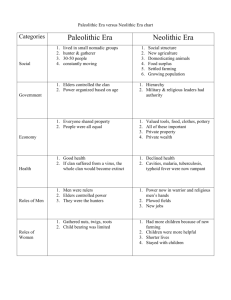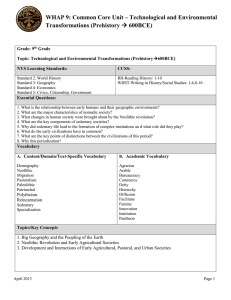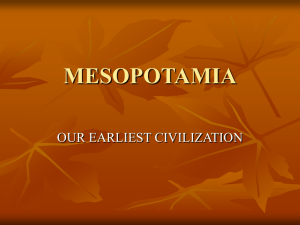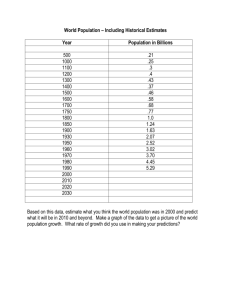File
advertisement
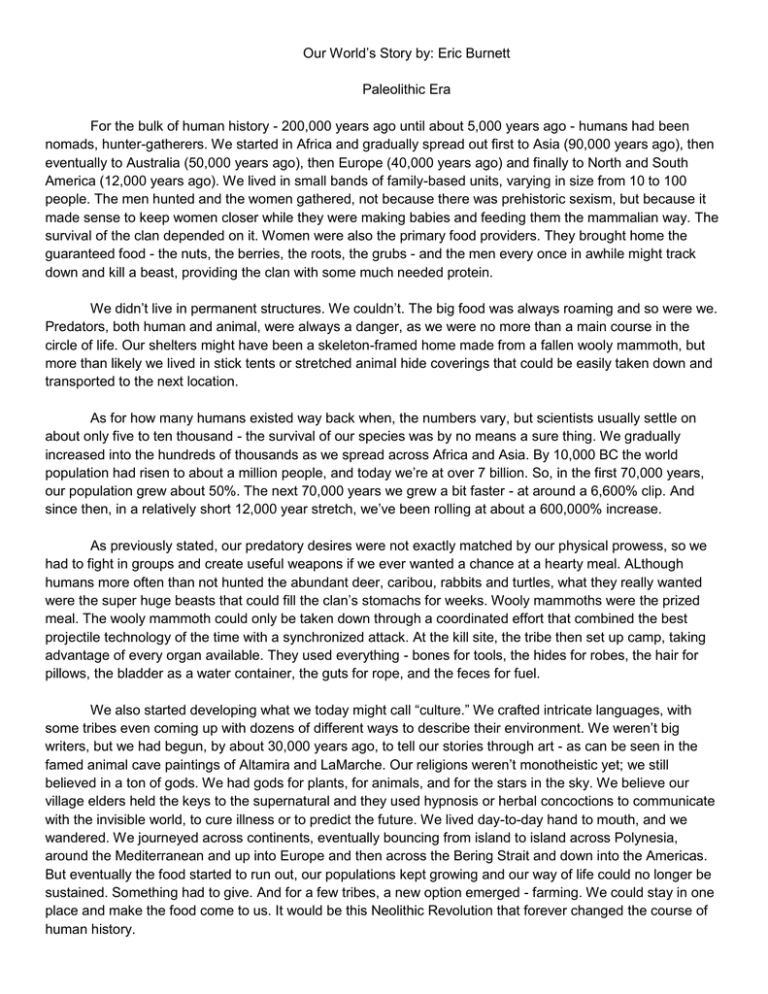
Our World’s Story by: Eric Burnett Paleolithic Era For the bulk of human history - 200,000 years ago until about 5,000 years ago - humans had been nomads, hunter-gatherers. We started in Africa and gradually spread out first to Asia (90,000 years ago), then eventually to Australia (50,000 years ago), then Europe (40,000 years ago) and finally to North and South America (12,000 years ago). We lived in small bands of family-based units, varying in size from 10 to 100 people. The men hunted and the women gathered, not because there was prehistoric sexism, but because it made sense to keep women closer while they were making babies and feeding them the mammalian way. The survival of the clan depended on it. Women were also the primary food providers. They brought home the guaranteed food - the nuts, the berries, the roots, the grubs - and the men every once in awhile might track down and kill a beast, providing the clan with some much needed protein. We didn’t live in permanent structures. We couldn’t. The big food was always roaming and so were we. Predators, both human and animal, were always a danger, as we were no more than a main course in the circle of life. Our shelters might have been a skeleton-framed home made from a fallen wooly mammoth, but more than likely we lived in stick tents or stretched animal hide coverings that could be easily taken down and transported to the next location. As for how many humans existed way back when, the numbers vary, but scientists usually settle on about only five to ten thousand - the survival of our species was by no means a sure thing. We gradually increased into the hundreds of thousands as we spread across Africa and Asia. By 10,000 BC the world population had risen to about a million people, and today we’re at over 7 billion. So, in the first 70,000 years, our population grew about 50%. The next 70,000 years we grew a bit faster - at around a 6,600% clip. And since then, in a relatively short 12,000 year stretch, we’ve been rolling at about a 600,000% increase. As previously stated, our predatory desires were not exactly matched by our physical prowess, so we had to fight in groups and create useful weapons if we ever wanted a chance at a hearty meal. ALthough humans more often than not hunted the abundant deer, caribou, rabbits and turtles, what they really wanted were the super huge beasts that could fill the clan’s stomachs for weeks. Wooly mammoths were the prized meal. The wooly mammoth could only be taken down through a coordinated effort that combined the best projectile technology of the time with a synchronized attack. At the kill site, the tribe then set up camp, taking advantage of every organ available. They used everything - bones for tools, the hides for robes, the hair for pillows, the bladder as a water container, the guts for rope, and the feces for fuel. We also started developing what we today might call “culture.” We crafted intricate languages, with some tribes even coming up with dozens of different ways to describe their environment. We weren’t big writers, but we had begun, by about 30,000 years ago, to tell our stories through art - as can be seen in the famed animal cave paintings of Altamira and LaMarche. Our religions weren’t monotheistic yet; we still believed in a ton of gods. We had gods for plants, for animals, and for the stars in the sky. We believe our village elders held the keys to the supernatural and they used hypnosis or herbal concoctions to communicate with the invisible world, to cure illness or to predict the future. We lived day-to-day hand to mouth, and we wandered. We journeyed across continents, eventually bouncing from island to island across Polynesia, around the Mediterranean and up into Europe and then across the Bering Strait and down into the Americas. But eventually the food started to run out, our populations kept growing and our way of life could no longer be sustained. Something had to give. And for a few tribes, a new option emerged - farming. We could stay in one place and make the food come to us. It would be this Neolithic Revolution that forever changed the course of human history. Neolithic Revolution In the centuries after 10,000 BC, as the ice started to melt and the rivers started to flow, across Europe, Africa and Asia, humans independently started making the one choice that would completely transform how they governed themselves, and how they interacted and how they worshipped. You can’t underestimate the impact of this shift from a nomadic lifestyle to an agricultural one. Once we established permanent roots and began pumping out our own food, we could turn our minds towards a host of different activities. We were no longer just surviving. For the first time, we could see what our minds could actually accomplish. We started building, inventing and philosophizing. We created governments, militaries, and religions. But, what did the four river valley civilizations have in common? It couldn’t just be that they were all near rivers. There are rivers on every continent in the world. There had to be something else. In the 1997 book Guns, Germs, and Steel, professor Jared Diamond of UCLA posed the theory that it all had to do with geography. To Diamond, a civilization's success had nothing to do with its inhabitants’ brains, brawn or skin color. It was all about what was above and below the ground. Some regions were abounded with all the needed little nuggets of nature. Others were not so lucky. For Asians and Europeans, they had every geographic advantage available. They won the ecological lottery. Diamond first contends that Europe and Asia’s animals were the easiest to domesticate. You could eat’em, shear’em, ride’em milk’em or hook’em up to a plow to help stir up your dirt. Diamond looked at all the animals in the world and calculated that there are only 148 that weigh over 100 pounds and eat vegetables. Of these, only 14 can actually be tamed. Eurasia has 13 of them. South America has only one - the llama. The rest of the world doesn’t have any. Oh sure, Africa has a ton of huge animals but good luck trying to get them to live peacefully on a farm. Crops meant more food. More food meant we needed bigger, better ways to store the food. We molded clay pots. We built huge stone granaries. At first, it was the priests who controlled these granaries, while also fulfilling their other duties as spokesmen to the gods. As more and more grain arrived, the granaries grew. They became temples, then palaces. Lured by the sedentary lives of these budding towns, nomadic huntergatherers threw down their spears once and for all. The population steadily grew and we started to run out of fertile land. We then had to build farms further and further away from the rivers. We needed canals to divert the river water. We set up taxes. If you wanted to stay in the town, you had to pay the priest with more grain or with your time. Eventually, priest turned their power over to military strongmen. These violent, born leaders enforced the taxes, protected the food reserves from foreigners and thieves and even mounted campaigns into neighboring lands to pull more territories under their domain. Also, once the farms provided enough nourishment for the society, women became permanent fixtures in the home. For nearly all of our first 200,000 years, the labor of women was seen as equal to that of men, but with the dawn of farming, the physical prowess of men was prioritized over anything a woman could provide. They couldn’t push the plow, mine the quarries or raise a sword or spear in battle. They remained at home and birth rates skyrocketed. Every new kid meant another worker for the farm.

